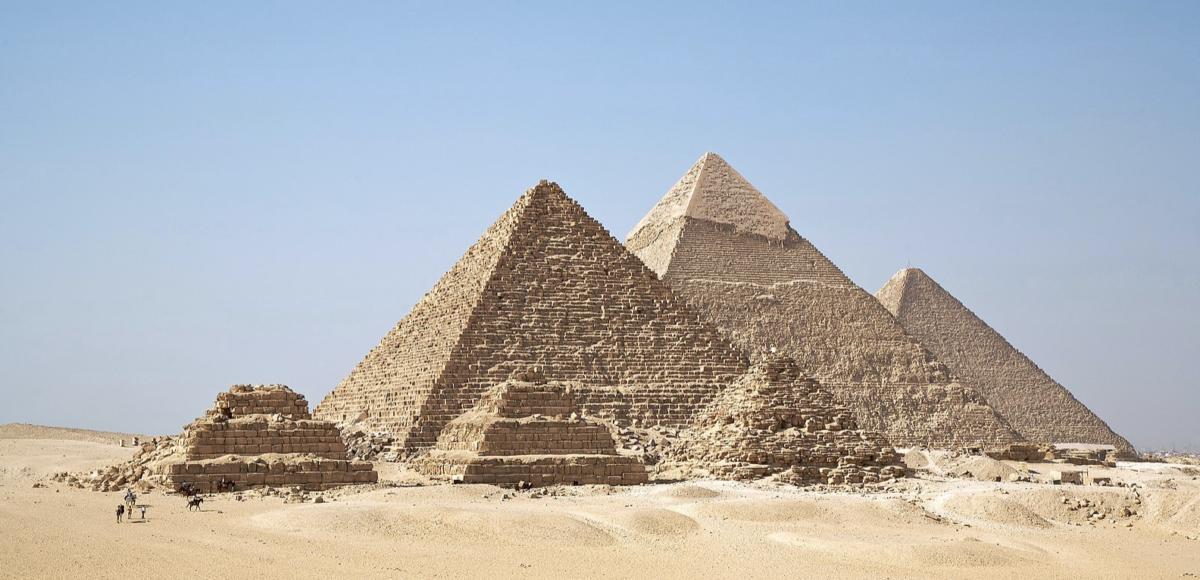(Music)
Pete Delkas: Hello listeners and welcome back to Back to the History: a show where we explore everything that is murky about history by time traveling; yes, time traveling. Today we are heading all the way back to the Ancient World exploring one of the greatest ancient civilizations to ever exist, the Egyptians. I’m your host, Pete Delkas, here with my co-host, Jesse Hawila, coming at you from our studio and time-machine in Dallas, Texas.
Jesse Hawila: Today we are discussing one of my favorite architectural phenomena in history, the Pyramids of Giza.
Pete: Yes that’s right, Jesse. We are diving deep into the mysteries, or shall we say soon to be uncovered mysteries, of how these magnificent structures were built; and if they were built by slaves.
Jesse: Well Pete, I can tell you right now that the Pyramids are clean. Built by the workers willingly and also obligingly, my friend.
Pete: Okay, Jesse, we will see about that. So give us a little rundown of why these Pyramids are so amazing.
Jesse: Well Pete, when we talk about Egypt, we go straight to the Nile River. This magical thing in the middle of the Sahara allows Ancient Egypt to truly flourish. When the Nile flooded, it brought peace throughout Egypt. Peace to build crazy things for their kings! An abundance of great floods will get the Pharaoh the praise for the Egyptians to build that guy one heck of a tombstone!

Pete: Wow Jesse I guess I better learn how to control the Nile so I can have myself a proper burial!
Jesse: That’s right, Pete. Couldn’t be better than being a respected and loved pharaoh. Now in our time machine we approach the beautiful structure of Khufu’s Pyramid in its construction.
Pete: Wow, Jesse. I mean look at that crazy thing. Even if it is built by slaves, it sure is a work of art.
Jesse: You will see Pete, just wait. One of the first things that stands out is the length of that causeway. Now if we swoop lower to the front of the Pyramid, we see it is shaped as a sun ray. And I think you could mistake that thing as a sun ray, that white tura limestone is BLINDING. But let’s get to the meat of the whole thing. Right now what we see appears to be a massive ramp all the way to the top of Khufu’s Pyramid. In the middle we can see the Grand Gallery, which is the majestic road leading to the King’s chamber at the top where Khufu will go.
Let’s zoom in on those workers down there. Wow, look at them move! Right now I see what appears to be one of those zas moving some stones to the top of the pyramid. Over here I can see a gang going down the Nile to collect those blinding limestone blocks from the quarry. One of the workers is writing graffiti on the block, too. It says “Friend’s of Khufu”.

Pete: Jesse, those guys are 100% slaves.
Jesse: See you might think so, but trust me they are happy to move this stuff. And come on, those guys are doodling on the blocks! You think a slave would be remotely allowed to do that?
Pete: I guess not. They are like kids drawing on their school desks. And I guess slaves wouldn’t call themselves friends of their master.
Jesse: Exactly my thought. And look at the Heit El Ghurab––the little town built for the workers. Those are solid dorms. And one of the workers is eating a steak! Slaves don’t eat steaks here. Plus one of the workers is getting his shoulder checked out.

Pete: I mean, I can only imagine the pain of moving a 2.5 ton block of stone, Jesse! Who would willingly do such a thing?

Jesse: Yeah, but Pete, if they were slaves they would not be receiving injury care like that. Slaves are replaceable, and if they die they sure won’t be getting buried with individual graves. Look at that cemetery. Pretty high honor for these guys to be buried so close to their king! I mean they aren’t even getting buried in their colonies from where they came from!
Pete: Well Jesse, I have to say one final thing I am skeptical about. Those workers had most likely been working on Khufu’s Pyramid for over 20 years nonstop and it is perfect. What workers would make it that perfect without being threatened and abused. I don’t know Jesse. I think I have you cornered.
Jesse: Well Pete, these workers believed the Pharaoh to be semi-divine. If a semi divine being ruled your land and did a good job, you would do whatever he asked wouldn’t you? As a matter of fact, it would probably be a high honor for you to build that pyramid, hence the cemetery and luxurious food.
Pete: Haha, alright you got me. These workers aren’t slaves. Thanks for joining us in Ancient Egypt, I’m Pete Delkas
Jesse: I’m Jesse Hawila
Pete: And this has been Back to the History. Tune in next episode where we talk about Stonehenge. How did those stones get there!
(Music)
Oliver Jones is a Freshman from Winnetka, Illinois. He worked on this with his friend, Aidan Sulimirski, who plays the role of Pete Delkas. Oliver, while not well versed in art history, grew to appreciate it from his visit to the Uffizi in Florence, Italy. Oliver is currently undecided, but intends on majoring in Economics.
